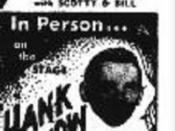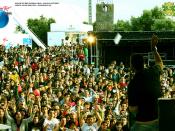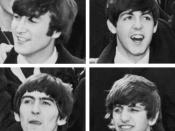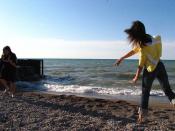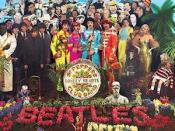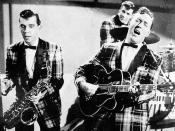Rock music was derived from many black and white American music styles such as: black guitar-accompanied blues; black rhythm and blues, saxophone solos; black and white gospel music; white country and western music; and the songs of white popular crooners and harmony groups. Rock music first emerged in 1954-55, and was initially named "rock 'n' roll." In 1964 it was renamed "rock music." The change in the music's name shows that its popularity remained despite the changes in the music; rock music was no longer just for dancing. After 1964, The Beatles were a major influence on rock music.
The first rock 'n' roll record to achieve huge popularity was "Rock Around the Clock" made by Bill Haley and the Comets in 1955. Haley's music appealed to the youth of the time as he had combined an exciting backbeat and interesting lyrics. The melody was played by electric guitar; the lyrics were simple but captivating.
Haley succeeded in ending the love of the bland and sentimental ballads popular in the 1940s and early 50s. Haley also managed to translate black rhythm and blues into a new form that the adolescent white audiences understood and loved.
Blues, and rhythm and blues, were seen as to adult and solely identified with black culture to be acceptable to the youth without Haley's adaptation of it. "Race records," had been produced for the black culture of the time for many years. The arrival of rock 'n' rolls showed a beginning of the collapse in the resistance to black culture. The black rock 'n' roll that Haley transformed can be heard in the work of such artists as Hank Ballard and the Midnighters ("Work with Me, Annie") or "Big" Joe Turner ("Shake, Rattle, and Roll"), the last song was adapted by Haley for white audiences and the first was transformed into "Dance with Me, Henry." Rock 'n' roll was for and about the youth. Its lyrics discussed teenage problems: school, cars, summer vacation, parents, and, most important, young love. The instruments of early rock 'n' roll were guitar, bass, piano, drums, and saxophone. All areas of the music: its heavy beat, loudness, lyrics, and raving delivery, indicated a teenage rebellion to adult values and authority. Crucial performers of the 1950s include Chuck Berry ("Johnny B. Goode"), Little Richard ("Good Golly Miss Molly"), Sam Cooke ("You Send Me"), Buddy Holly ("Peggy Sue"), Jerry Lee Lewis ("Great Balls of Fire"), and Carl Perkins ("Blue Suede Shoes").
Buddy Holly (Charles Hardin Holley) A Singer and guitarist who was one of the first rock and roll musicians. Holly was in a band named The Crickets. With his band he recorded songs such as: "That'll be the Day" (1957) and "Peggy Sue" (1957). Holly was to be a major influence on future bands like The Beatles and Bob Dylan. He died in a plane crash in 1959. Origins of Rock Music The greatest man in rock 'n' roll from 1956 to 1963 was Elvis Presley. He began life as a truck driver who was desperate to sing. Presley was from Tupelo, Mississippi. His dynamic delivery and sexuality appealed to young audiences whilst horrifying older people. When, record companies that had considered rock"n"roll to be a fad caught on to its popularity they began to desperately search for new singers; they mostly succeeded in commercialising the music and ruining most of its rebellious quality. At the start of the new decade Detroit became an important centre for black singers, and a certain new type of music known as "Motown" (motor town). This style usually consisted of a lead singer, singing a melody story line to the harmonies of a backup group. Popular groups of this style are the Temptations, Smokey Robinson and the Miracles, Diana Ross and the Supremes, and Gladys Knight and the Pips. Rock music again surged to popularity in 1962 with the emergence of a new group, the Beatles, a group of four longhaired lads from Liverpool. They were initially appreciated for their energy and personality rather than for their music. Their popularity inevitably lead to other groups with unusual names appearing on the music scene. One of the most important of these was the Rolling Stones, whose music reflected the black blues tradition. These British bands signified a return of the black blues sound, but with a much louder and electronic sound.
Elvis Presley 1935-77 An American popular singer, from Tupelo, Mississippi. He was exposed to gospel music from a young age. Presley began playing guitar before his adolescence. He first recorded in 1953, and became a national sensation by 1956; he solely dominated rock music until 1963. Elvis Presley sang successfully in three styles: country and western, rock 'n' roll, and rhythm and blues. Although equipped with a respectable baritone voice and a sincere delivery, it was his pelvic motions, which were considered extremely sexual by the teenage generation, which exploded Presley to fame. He appalled adults with his sexual motions, but delighted the majority of people. Some of his most successful songs were "Heartbreak Hotel," "Love Me Tender," "Hound Dog," and "Don't Be Cruel." He also appeared motion pictures such as Love Me Tender (1956) and Follow That Dream (1962). Presley remained extremely popular and influential throughout the 1960s and 70s. His death was mainly due to his persistent drug abuse. Since his death, the interest in him has remained high; his home, Grace land, in Memphis, Tennessee, has become a highly successful tourist attraction.
An important transformation of rock occurred in 1965 at the Newport Folk Festival. Bob Dylan, a composer well known for writing poetic folk songs and songs of social protest like "Blowin' in the Wind," appeared, playing electric guitar and was backed by an electrified rock band. A combination of the newly revived folk and rock subsequently took place, with folk groups using rock beats and tempos, and rock singers using poetic folk like lyrics for their songs (e.g., the Beatles' "Norwegian Wood," and "Eleanor Rigby"). Performers like the Mamas and the Papas; Peter, Paul, and Mary; Donovan; and the Lovin Spoonful sang a type of music named "folk rock.
In the 1960s music mirrored the tensions of the Vietnam War and played a hugely important role in American culture. The lyrics of rock songs turned extremely rebellious discussing issues of social protest, sex, and, increasingly, drugs. Many groups such as Jefferson Airplane and the Grateful Dead, tried to describe the extreme experience of psychedelic drugs in their songs. These songs were usually long and repetitive with surreal lyrics. This new type of rock became known as "acid rock" or sometimes "hard rock".
In 1967 the Beatles again made history with their new album Sgt. Pepper's Lonely Hearts Club Band. This was largely due to the drug-oriented songs it contained. This is considered the first "concept album." The products of this new trend were rock musicals such as Hair (1968) and rock operas like Tommy, composed and sung by the Who.
The Beatles English rock music group that formed in the late 1950s and split up in 1970. The members were: John Lennon (1940-80) who played the guitar and harmonica; Paul McCartney (1942- present) who played the guitar and piano; George Harrison (1943-2002) who played the guitar and sitar; and Ringo Starr. (Richard Starkey 1940- present) who played the drums. All of them were born in Liverpool. American performers such as Chuck Berry, Little Richard, and Elvis Presley were The Beatles main influences. Just as Elvis had dominated the 1950s,The Beatles dominated rock music in the 1960s. The group eventually split when they felt they had achieved all they could do together. John Lennon and Paul McCartney were responsible for most of the lyrics and music for their song.
By the late 1960s rock had taken its place as an important music form. Artists like Miles Davis, John McLaughlin and groups like Traffic or Blood, Sweat, and Tears tried to combine rock and jazz, whilst artists such as Leonard Bernstein and Frank Zappa tried to entwine rock and classical music together. Groups featuring guitarists such as Jimi Hendrix, Eric Clapton, Duane Allman, and Jimmy Page continued to perform adaptations on classic blues styles using the traditional instruments of rock 'n' roll. From 1967 onward, thousands of fans began attending rock concerts; these concerts were seen as the best way to hear the music you loved. The most successful of these rock festivals was, Woodstock. This festival was held near Bethel, New York, in August 1969. A similar event, that featured the Rolling Stones, was held at Altamont, California the same year. This festival was not as peaceful as Woodstock had been and was marked by several violent incidents, which were caught on film, including a murder. By 1970 most of rocks top performers such as: Janis Joplin, Jim Morrison, and Jimi Hendrix, were dead from substance abuse. The Rolling Stones projected a dangerous image, which was taken to extremes by performers such as Alice Cooper and David Bowie. These performers were almost as famous for their sexual ambiguity and outrageous behaviour as for their music.
Rock music had a huge turning in the late 1970s it was called, punk rock. This new form of rock was a nihilistic political statement. This form of rock was first played in Great Britain by bands such as the Sex Pistols and the Clash. Punk quickly became popular in the United States. By the early 1980s, rock music had changed considerably because of punk rock. Many bands such as: Black Flag and the Dead Kennedy's, adopted political protest themes as the core of their music.
During the 1980s music videos became a hugely popular form of promoting rock music. In the late 1980s, several bands, such as Nirvana and Pearl Jam, followed the path of early punk rock by focusing on political themes in their songs. In the 1990s older bands such as the Grateful Dead and the Rolling Stones remained hugely popular. In 1995 the Rock and Roll Hall of Fame in Cleveland, Ohio was opened, it reflected the continuing love of the older bands as well as the new bands.
